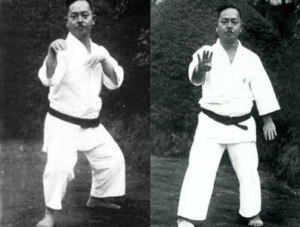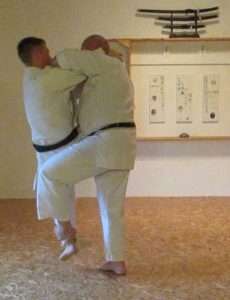Tracing the transformation of karate from a grappling art to a kicking and punching discipline.
Itosu Anko and Funakoshi’s vision.
In the early 1900s, Itosu Anko embarked on a revolutionary journey to adapt karate to physical education, paving the way for the art’s widespread acceptance. Recognizing the need to make karate more accessible to Okinawan schoolchildren, Itosu introduced simplified forms and placed a strong emphasis on fundamental techniques. His visionary approach transformed karate into a discipline that could be effectively taught within the confines of physical education. Itosu’s efforts laid the groundwork for karate’s evolution and its subsequent impact on a global scale.
Building upon Itosu’s work, Gichin Funakoshi carried the torch forward, further refining and elevating karate. Funakoshi understood that for karate to transcend mere physical combat, it needed to encompass cultural and philosophical values. With unwavering dedication, Funakoshi infused karate with the rich tapestry of Japan’s heritage, shaping it into a discipline that embraced not only physical prowess but also spiritual growth. The blending of technique and philosophy had a profound impact, driving karate to become a well-rounded sport. Karate-do was born.
Through their shared vision, Itosu Anko and Gichin Funakoshi laid the foundation for karate’s transformation. Itosu’s adaptation of physical education and Funakoshi’s integration of cultural and philosophical values set the stage for the art’s journey from a localized practice to a discipline that would leave an indelible mark on the world stage. Their contributions served as inspiration for future generations of karate practitioners, shaping the art into what it is today.
Kenwa Mabuni’s enduring influence.
While the contributions of Itosu Anko and Gichin Funakoshi played pivotal roles in shaping karate’s evolution, it is important to acknowledge the significant impact of Kenwa Mabuni. Arriving in mainland Japan in 1928, Mabuni brought with him a wealth of knowledge and expertise in various Okinawan martial arts.

Kenwa Mabuni’s influence on karate cannot be overlooked, although his impact may not have been as profound as that of Gichin Funakoshi. Mabuni’s contributions lie in his technical innovations and the unique synthesis of different Okinawan martial arts styles. His efforts resulted in the development of his own distinct style, known as Shito-ryu, which blended both the hard and soft aspects of karate.
While Funakoshi’s introduction of karate in mainland Japan and the establishment of Shotokan style shaped the direction of karate on a national and international level, Mabuni’s legacy remains noteworthy. His technical innovations, dedication to preserving traditional forms, and efforts in popularizing karate left an indelible mark on the art’s history. Mabuni’s contributions continue to be recognized and celebrated by practitioners of Shito-ryu and karate as a whole.
The decline and neglect of grappling techniques.
Grappling techniques, once an integral part of karate’s repertoire, experienced a diminishing presence throughout the introduction of karate to Okinawan schools by Itosu Anko and the subsequent modifications made by Gichin Funakoshi and his son Yoshitaka “Gigo” Funakoshi. As karate was adapted for physical education and introduced to a wider audience, the emphasis shifted towards striking techniques and other aspects that were deemed more suitable for mass instruction. In this process, grappling techniques were gradually relegated to the background, losing their prominence and being overshadowed by other facets of the art.

Nevertheless, a closer examination of Okinawan kata, the traditional forms and movements of karate, reveals vestiges of grappling techniques. Throws, joint locks, chokes, strangles, grips, counters, and more can still be found within these ancient katas, providing glimpses into karate’s grappling heritage. It is through the analysis of these forms that the essence of grappling within karate can be rediscovered and appreciated.
However, it is important to acknowledge that the modernization of karate kata has brought about significant alterations in the execution and interpretation of these forms. As karate evolved and adapted to different contexts and influences, the execution of kata has been modified, making it more challenging to discern and fully comprehend the original intent of the grappling techniques embedded within them.
Despite these challenges, many dedicated practitioners and schools recognize the value of incorporating grappling techniques into their karate practice. They understand that a comprehensive understanding of karate as a complete system of fighting necessitates the inclusion of grappling. By embracing grappling alongside striking techniques, practitioners can cultivate a well-rounded skill set, ensuring a more comprehensive and effective approach to self-defense.
Sportskarate’s impact: A shift in focus.
The introduction of sportskarate by JKA (Japan Karate Association), with Masatoshi Nakayama in the lead, around 1949/50 brought a shift in the essence of karate as a self-defense system. This transformative era prioritized long-range combat and scoring points, leading to a reimagining of karate techniques and strategies.
